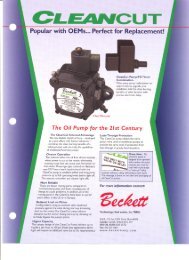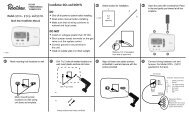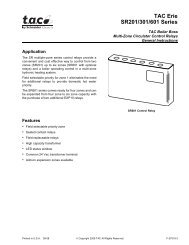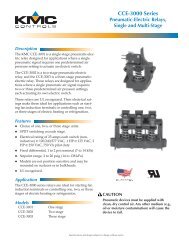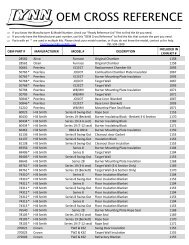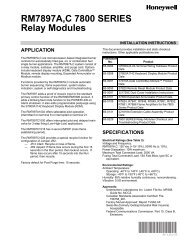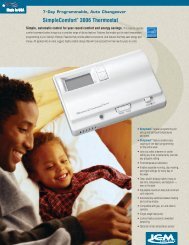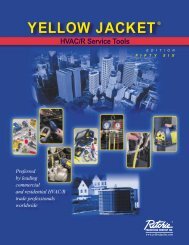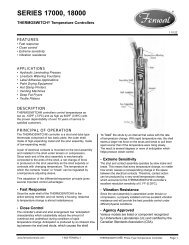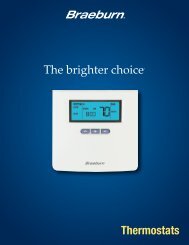Installation Manual - Jackson Systems
Installation Manual - Jackson Systems
Installation Manual - Jackson Systems
Create successful ePaper yourself
Turn your PDF publications into a flip-book with our unique Google optimized e-Paper software.
Builder Series<br />
Non-Programmable Thermostats<br />
MODEL<br />
1000, 1000NC<br />
MODEL<br />
1200, 1200NC<br />
WARNING<br />
Important Safety Information<br />
Single Stage Heat / Cool<br />
Conventional and Heat Pump<br />
Multi-Stage 2 Heat / 1 Cool<br />
Conventional and Heat Pump<br />
Before Installing, Programming or Operating,<br />
PLEASE READ ALL INSTRUCTIONS<br />
1<br />
2<br />
3<br />
4<br />
Specifications<br />
<strong>Installation</strong><br />
Testing Your New Thermostat<br />
Programming User Settings<br />
Additional Operation<br />
Features<br />
Troubleshooting<br />
Wiring Diagrams<br />
• Always turn off power to the air conditioning or heating system prior to<br />
installing, removing, cleaning or servicing thermostat.<br />
• This thermostat is a dual power thermostat and either requires 24 Volts AC<br />
Power or two (2) properly installed “AA” alkaline batteries for normal<br />
operation and control of the heating or cooling system.<br />
• This thermostat should only be used as described in this manual. Any other<br />
use is not recommended and will void the warranty.<br />
1 Specifications<br />
© 2004 Braeburn <strong>Systems</strong> LLC • Patents Pending • All Rights Reserved. Pub. No. 1000-100-009<br />
5<br />
6<br />
7<br />
• Electrical Rating: 24 Volt AC (18-30 Volt AC)<br />
1 amp maximum load per terminal<br />
2 amp total maximum load (all terminals) (Model 1000, 1000NC)<br />
3 amp total maximum load (all terminals) (Model 1200, 1200NC)<br />
• Control Range: 45˚ - 90˚ F (7˚- 32˚ C)<br />
• Accuracy: +/- 1˚ F (+/- .5˚ C)<br />
• AC Power: 18-30 Volt AC<br />
• DC Power: 3.0 Volt DC (2 AA Alkaline batteries included)<br />
1 Specifications cont.<br />
• Model 1000, 1000NC: Compatibility with low voltage single stage gas, oil or<br />
electric heating or cooling systems, including single stage heat pumps, can<br />
also be used on 250mv to 750mv millivolt heating only systems.<br />
• Model 1200, 1200NC: Compatibility with low voltage multi-stage gas, oil or<br />
electric heating or cooling systems, including multi-stage heat pumps.<br />
• Terminations, Model 1000, 1000NC: Rc, Rh, B, O, Y, W, G, C<br />
• Terminations, Model 1200, 1200NC: R, O, B, C, Y1, E/W1, G, W2<br />
2<br />
<strong>Installation</strong><br />
Replacing Existing Thermostat<br />
1. Always turn off power to the air conditioning or heating system prior to<br />
removing existing thermostat.<br />
2. Remove the cover of your old thermostat and locate the wire terminals.<br />
Do not remove wires from terminals yet.<br />
3. Using small pieces of masking tape, label wires prior to removal from<br />
terminals. Use the chart below to determine the new terminal designations<br />
for your new thermostat.<br />
Old Terminal from<br />
Existing Thermostat<br />
New Terminal for<br />
New Thermostat<br />
(1000, 1000NC)<br />
1<br />
New Terminal for<br />
New Thermostat<br />
(1200, 1200NC)<br />
Terminal<br />
Description<br />
V or Rc Rc Cooling<br />
Transformer<br />
M, 4, Rh, or R Rh Heating<br />
Transformer<br />
R, V-VR or VR-R R 24 VAC<br />
B B B Reversing Valve<br />
(Heating)<br />
O O O Reversing Valve<br />
(Cooling)<br />
Y, Y1 or M Y Y1 Cooling or<br />
Compressor for<br />
HP System<br />
E, H, W, or 4 W E/W1 1st Stage Heat<br />
or Emergency Heat<br />
G or F G G Fan Control<br />
C, X or B C C 24 VAC Common<br />
4. After labeling and removing all wires from terminals, unscrew the existing<br />
thermostat sub-base from wall. Secure wires to prevent them from slipping<br />
into the hole in the wall.<br />
NOTE–MODEL 1000, 1000NC: This thermostat is designed for use with 24<br />
Volt-AC low voltage single stage gas, oil or electric heating or cooling systems,<br />
including single stage heat pumps and can also be used on 250mv to 750mv<br />
millivolt heating only systems. Do not use this thermostat on applications with<br />
voltages above 30 Volts AC.<br />
NOTE–MODEL 1200, 1200NC: This thermostat is designed for use with 24<br />
Volt-AC low voltage multi-stage gas, oil or electric heating or cooling systems,<br />
including multi-stage heat pump systems. Do not use this thermostat on<br />
applications with voltages above 30 Volts AC.
2 <strong>Installation</strong> cont.<br />
2 <strong>Installation</strong> cont.<br />
Installing Your New Thermostat<br />
NOTE: If installing this thermostat in a new installation, locate the thermostat<br />
4 to 5 feet above the floor in accordance with applicable building codes. Install<br />
the thermostat in a location that provides good airflow characteristics and avoid<br />
areas behind doors, near corners, air vents, direct sunlight or heat generating<br />
devices. <strong>Installation</strong> in these areas could impact thermostat performance.<br />
Wiring must conform to all building codes and ordinances as required by local<br />
and national code authorities having jurisdiction.<br />
1. Turn off power to the air conditioning or heating system prior to<br />
installing thermostat.<br />
2. Place system switch on front of thermostat to OFF position.<br />
3. Place fan control switch on front of thermostat to AUTO position.<br />
4. Remove front of thermostat body from sub-base by pressing release latch.<br />
5. Place the thermostat sub-base against wall in the desired thermostat location.<br />
6. Guide thermostat wires through hole in sub-base. Continue to hold<br />
against wall.<br />
7. Mark placement of mounting holes as appropriate and drill using a 3/16"<br />
drill bit.<br />
8. Gently tap supplied plastic anchors into the holes in the wall.<br />
9. Place the thermostat sub-base against the wall in the desired location,<br />
making sure the mounting holes are aligned and the thermostat wires are<br />
inserted into the opening in sub-base.<br />
10. Fasten sub-base to wall using supplied screws.<br />
11. Connect wires to quick wiring terminal block using the new terminal<br />
designations. See section 7.<br />
12. Make sure all of the wire connections are secure and not touching any other<br />
terminal to prevent electrical shorts and potential damage to the thermostat.<br />
13. Turn the front thermostat body over, exposing the rear view of the<br />
circuit board.<br />
14. Locate the internal ˚F /˚ C switch on the circuit board. Using your fingers,<br />
flip the switch toward the preferred temperature ˚F / ˚C scale.<br />
15. Locate the internal fan option switch, HG (Gas) / HE (Elec) on the circuit<br />
board. This switch controls the heating system fan delay. Select gas for gas<br />
or oil fired systems. This will allow the furnace to run for a few seconds<br />
before initiating the fan. Select electric for systems with electric furnace<br />
elements that require the fan to come on immediately. Using your fingers,<br />
flip the switch toward HG (Gas) or HE (Elec).<br />
NOTE: For heat pump systems, the fan option switch should be set according to<br />
the second stage heating system type.<br />
16. Locate the internal NORM / HP switch on the circuit board. This switch<br />
configures the thermostat for conventional (NORM) heating and cooling<br />
systems or heat pump (HP) systems. Using your fingers, gently flip the<br />
switch toward NORM or HP.<br />
17. Attach front body of thermostat to sub-base of thermostat, being careful<br />
to align the terminal pins on the front body with the terminal block on<br />
the sub-base.<br />
18. Open front thermostat door and open battery compartment door.<br />
19. Install two new "AA" alkaline batteries. Locate the positive (+) ends of the<br />
batteries and match them with the positive (+) terminals located in the<br />
battery compartment. Close battery compartment.<br />
20. Restore system power so you can test installation.<br />
NOTE: If the thermostat was powered (batteries installed) prior to accomplishing<br />
steps 14 through 16, you will need to reset the thermostat to register thermostat<br />
switch configurations prior to programming any user settings. Gently press<br />
the RESET button on the front of the thermostat using a paperclip or a small<br />
pencil tip.<br />
NOTE – MODEL 1200, 1200NC: If the thermostat is<br />
configured for a conventional system and the system<br />
switch is in the EM HEAT position, the unit will still<br />
function in a conventional 2 stage HEAT mode, but<br />
the display will flash NO AUX SET.<br />
Testing Your New Thermostat<br />
WARNING! Read BEFORE Testing<br />
2 3<br />
3<br />
• Do not short (or jumper) across terminals on the gas valve or at the heating or<br />
cooling system control board to test the thermostat installation. This could<br />
damage the thermostat and void the warranty.<br />
• Do not select COOL mode if the outside temperature is below 50˚ F (10˚ C).<br />
This could damage the controlled cooling system and cause personal injury.<br />
• This thermostat includes an automatic compressor protection feature to<br />
avoid potential damage to the cooling system from short cycling. This<br />
thermostat automatically provides a 5-minute delay after turning off the<br />
cooling or heating system output to protect the compressor.<br />
NOTE: Test your thermostat prior to programming any user settings. Pressing<br />
the RESET button will erase any user entries previously programmed and return<br />
them to their default values.<br />
1. Place the system switch in the HEAT position.<br />
2. Press the button on the keypad until the set point temperature setting is a<br />
minimum of 3 degrees higher than the current room temperature. The heating<br />
system should start within several seconds. The fan may not turn on<br />
immediately due to the heating system built-in fan delay.<br />
3. Place the system switch in the OFF position. The heating system should stop<br />
within several seconds with conventional heating or cooling systems. On heat<br />
pump systems you must wait 5 minutes for the automatic compressor short<br />
cycle protection period to expire, or press the RESET button to bypass this<br />
feature for initial testing purposes. Pressing the RESET button will erase any<br />
user program settings.<br />
4. Place the system switch in the COOL position.<br />
5. Press the button on the keypad until the set point temperature is a minimum<br />
of 3 degrees lower than the current room temperature.<br />
6. The cooling system should start within several seconds. Place the system<br />
switch in the OFF position. The cooling system should stop within a few seconds.<br />
7. Place the fan switch in the ON position. The system blower should start.<br />
8. Place the fan switch in the AUTO position. The system blower should stop.
4<br />
Programming User Settings<br />
Default Thermostat Settings<br />
Function<br />
Operation Mode<br />
Room Temperature<br />
Set Point Temperature<br />
Temperature Scale<br />
Low Battery Warning<br />
1st Stage Differential<br />
Setting Temperature Differentials<br />
The default settings for the first and second stage differentials are compatible<br />
with most systems and applications. This is normally set at time of installation and<br />
usually does not require any modification under normal operating conditions. If you<br />
feel that your system is turning on too often, simply follow the instructions below.<br />
NOTE: The first and second stage differential settings are the same for both the<br />
heating and cooling systems.<br />
Setting First Stage Differential<br />
Status After Reset<br />
Normal Operating Mode<br />
70˚ F (21.0˚ C), to be<br />
renewed within 5 seconds<br />
According to system switch<br />
Heat or Off: 62˚ F (17.0˚ C)<br />
Emergency Heat (1200 and 1200NC only):<br />
62˚ F (17.0˚ C)<br />
Cool: 85˚ F (29.0˚ C)<br />
˚F or ˚C dependent switch setting<br />
Off, to be renewed within 5 seconds.<br />
Off if 24V is present<br />
0.5˚ F (0.25˚C)<br />
2nd Stage Differential 2˚ F (1.0˚ C)<br />
Short Cycle Protection Timer<br />
Output Relays<br />
Reset<br />
The default setting is 0.5˚ F (0.25˚ C). The room temperature must change .5˚ F<br />
(0.25˚ C) from the set point temperature before the thermostat will initiate the<br />
system in heating or cooling.<br />
1. In normal operating mode, press and hold the and<br />
buttons at the same time for 3 seconds. LCD display will<br />
show "SET D1 x˚", where "x" equals the ˚F / ˚C differential<br />
setting. This is the current first stage differential setting.<br />
2. Press the or buttons to set the first stage differential<br />
to your desired setting of .5˚, 1˚, or 2˚ F (.25––displayed as<br />
.3˚, .5˚ or 1.0˚ C).<br />
Off<br />
NOTE–MODEL 1000, 1000NC: Once you have finished setting the first stage<br />
differential, you can wait 5 seconds and the thermostat will return to the normal<br />
operating mode. Or you can press both the and buttons at the same time to<br />
return to normal operating mode.<br />
NOTE–MODEL 1200, 1200NC: If you do not wish to change the second stage<br />
differential, you can wait 5 seconds and the thermostat will automatically return<br />
to the normal operating mode. Otherwise, you can press both the and<br />
buttons at the same time to return to normal operating mode.<br />
4<br />
4<br />
5<br />
Programming User Settings cont.<br />
Setting Second Stage Differential<br />
The default setting is 2˚ F (1.0˚ C). The room temperature<br />
must change 2˚ F (1.0˚ C) in addition to the first stage<br />
differential setting before the thermostat will initiate the<br />
second stage of the system in heating.<br />
3. Press and hold the and buttons at the same time<br />
again and the LCD display will show "SET D2 x˚", where "x" equals the ˚F / ˚C<br />
differential setting. This is the current second stage differential setting.<br />
4. Press the or buttons to set the second stage differential to your desired<br />
setting of 2˚, 3˚, 4˚, 5˚ or 6˚ F (1˚, 1.5˚, 2˚, 2.5˚ or 3˚ C).<br />
NOTE – MODEL 1200, 1200NC: Once you have finished setting the second stage<br />
differential, you can wait 5 seconds and the thermostat will return to the normal<br />
operating mode. Or you can press both the and buttons at the same time to<br />
return to normal operating mode.<br />
NOTE: To erase all user program settings, gently press the RESET button using<br />
a paper clip or a small pencil tip. This will return all thermostat settings to their<br />
default values, erasing all program settings entered by the user.<br />
Additional Operation Features<br />
NOTE: This thermostat has separate heating and cooling set points, which<br />
can be reviewed or changed by selecting either HEAT or COOL with the<br />
system switch.<br />
Review Set Temperature<br />
1. Press and hold the or button. The current set point<br />
temperature will be displayed in place of the current<br />
room temperature, and the indicator SET will be displayed.<br />
2. The display will return to normal operating mode when<br />
the or buttons are released. The SET indicator will<br />
turn off, indicating that the current temperature shown in the display is the<br />
room temperature.<br />
Changing Set Temperature<br />
1. Press and hold the or button for more than 1 second.<br />
The entire display will flash once and the SET indicator<br />
will be flashing. Release the or button and press<br />
the or button again to adjust the set temperature.<br />
2. The display will return to normal operating mode after 5<br />
seconds, or you can press both the and buttons at<br />
the same time to return to normal operating mode.<br />
3. The SET indicator will turn off in the display, indicating<br />
that the current temperature shown in the display is the<br />
room temperature.<br />
5
5<br />
Additional Operation Features cont.<br />
6<br />
Troubleshooting<br />
Compressor Protection Feature<br />
This thermostat includes an automatic compressor protection feature to avoid<br />
potential damage to the system from short cycling. This thermostat automatically<br />
provides a 5-minute delay after turning off the cooling system output to protect<br />
the compressor. This protection is also present in the heat mode of operation on<br />
heat pump systems to protect the compressor.<br />
NOTE: The installer can bypass the compressor protection feature by pressing<br />
the RESET button. This will erase all user program settings, returning all settings<br />
to their default values. This should only be used during installation for testing<br />
purposes or to reset a thermostat to regain normal operation.<br />
Low Battery Detection and Replacement<br />
This thermostat requires two (2) properly installed "AA" alkaline batteries to<br />
provide power for the thermostat if 24 volt AC power is not connected to the<br />
terminal block. This thermostat is equipped with a unique, three level low<br />
battery detection feature that constantly monitors the batteries during normal<br />
operating mode to determine whether they have sufficient power to provide<br />
proper operation.<br />
When this feature determines that the battery status is low, a low battery<br />
indicator will appear in the display. After 30 days the battery indicator will<br />
start to flash, and after 60 days the battery indicator will begin to flash faster,<br />
indicating that the batteries need to be replaced immediately to maintain<br />
system operation and program settings.<br />
Replacing the Batteries<br />
1. Open front cover and locate the battery compartment door.<br />
2. Gently remove the two "AA" alkaline batteries located in<br />
the battery compartment.<br />
3. Install two new "AA" alkaline batteries into battery<br />
compartment. Make sure to match the positive (+) ends<br />
of the batteries with the positive (+) terminals located in<br />
the battery compartment.<br />
4. Close battery compartment. The low battery indicator should not appear<br />
in display.<br />
Non-Volatile Memory<br />
In the event of a power failure, the Non-Volatile Memory feature allows all<br />
settings to be recovered, eliminating the need to reset temperature and<br />
differential settings. When AC power is restored after an outage or batteries<br />
are reinserted, all settings are retrieved from memory and reinstated.<br />
Status Indicators (Model 1200 and 1200NC Only)<br />
There is one status indicator that can be displayed to notify<br />
you of key system information.<br />
AUX: This will turn on when the auxiliary second stage of<br />
heating is active. The auxiliary stage of heating is usually<br />
the least economical stage of heat.<br />
Symptom: Thermostat does not turn on heating or cooling system.<br />
Potential Solution: Check to see if OFF is shown in display. This indicates that the<br />
system is turned off at the thermostat. Move system selector switch to HEAT or COOL<br />
position. After the compressor short cycle protection 5-minute period expires, the<br />
system should start.<br />
Compressor protection feature may be in effect due to compressor short cycle<br />
conditions. See Section 5.<br />
Heating or cooling system may be malfunctioning. Call a professional service technician<br />
immediately to verify system operation.<br />
Symptom: Thermostat turns on heating instead of cooling, or cooling instead of heating.<br />
Potential Solution: Check thermostat wiring to make sure the heating and cooling<br />
stages are connected to the correct terminals on the wiring block. See Section 7.<br />
Symptom: Thermostat turns heating or cooling system on too often or not often enough.<br />
Potential Solution: Increase or decrease temperature differential settings as appropriate<br />
to provide the desired performance level. See Section 4.<br />
Symptom: Low battery indicator is blinking in thermostat display.<br />
Potential Solution: Replace batteries immediately to maintain proper system operation.<br />
See Section 5.<br />
Symptom: OFF is shown in thermostat display and heating or<br />
cooling system will not start.<br />
Potential Solution: This indicates that the system is turned off<br />
at the thermostat. The thermostat must be in HEAT or COOL<br />
mode of operation to control the heating or cooling system.<br />
Move the system selector switch to the HEAT or COOL position.<br />
Symptom: Thermostat display is blank.<br />
Potential Solution: It is possible that AC power is not present at the thermostat, and/or<br />
the batteries are drained. Check fuse, circuit breaker and thermostat wiring as<br />
appropriate to verify AC power is available. Replace batteries before reprogramming<br />
thermostat. See Section 5. If AC power is present, call a professional service technician<br />
to verify thermostat and system performance.<br />
Symptom: HI is shown in the thermostat display.<br />
Potential Solution: The temperature sensed by the thermostat<br />
is higher than the 99˚ F (37˚ C) upper limit of the thermostat’s<br />
display range. The display will return to normal after the sensed<br />
temperature lowers within the 40˚ to 99˚ F (4˚ to 37˚ C) display<br />
range. Turn on the cooling system or use other methods to lower<br />
the temperature accordingly.<br />
This condition could occur from the system being turned off during an exceptionally<br />
warm period or upon installation when the thermostat has been stored for a long<br />
period of time in a warm vehicle or location prior to being installed.<br />
Symptom: NO AUX SET is shown in the thermostat display.<br />
(model 1200 and 1200NC only)<br />
Potential Solution: The thermostat (model 1200 and 1200NC<br />
only) is configured for a conventional system, and the system<br />
switch is in the EM HEAT position. The unit will still function in<br />
a conventional 2 stage HEAT mode, but the display will flash<br />
NO AUX SET. Move the system switch to the HEAT position.<br />
6 7
6<br />
Troubleshooting<br />
cont.<br />
7<br />
Wiring Diagrams<br />
cont.<br />
Symptom: LO is shown in the thermostat display.<br />
Potential Solution: The temperature sensed by the thermostat<br />
is lower than the 40˚ F (4˚ C) lower limit of the thermostat’s<br />
display range. The display will return to normal after the sensed<br />
temperature rises within the 40˚ to 99˚ F (4˚ to 37˚ C) display<br />
range. Turn on the heating system to raise the temperature as<br />
needed for comfort within the room.<br />
This condition could occur from the system being turned off during a cold weather<br />
period or upon installation when the thermostat has been stored for a long period of<br />
time in a cold vehicle or location prior to being installed. The thermostat should be<br />
allowed to warm up prior to installation to allow proper heating control once installed.<br />
Symptom: Cannot program a set point temperature higher than 90˚ F (32˚ C).<br />
Potential Solution: This is above the normal thermostat temperature setting range of<br />
45˚ to 90˚ F (7˚ to 32˚ C).<br />
Symptom: Cannot program a set point temperature lower than 45˚ F (7˚ C).<br />
Potential Solution: This is below the normal thermostat temperature setting range of<br />
45˚ to 90˚ F (7˚ to 32˚ C).<br />
Symptom: Fan continues to run whether the system is on or off.<br />
Potential Solution: Check that the fan control switch is in the AUTO position. This will<br />
allow the fan to run only when the heating or cooling system is turned on and running.<br />
Check thermostat wiring to make sure that the fan control wiring is connected to the<br />
correct terminals on the wiring block. See Section 7.<br />
Symptom: The room is too warm or too cold.<br />
Potential Solution: See Section 5. Review current set point and change as necessary.<br />
7<br />
Wiring Diagrams<br />
MODEL 1000, 1000NC: Single Stage Conventional <strong>Systems</strong> (Single Transformer)<br />
Factory Installed<br />
Jumper<br />
Rc Rh B O Y W G<br />
Cool<br />
Control<br />
Heat<br />
Control<br />
Fan<br />
Control<br />
C<br />
Transformer Common<br />
(See NOTE 1)<br />
MODEL 1000, 1000NC: Single Stage Conventional <strong>Systems</strong> (Dual Transformer)<br />
Remove<br />
Factory Installed<br />
Jumper<br />
Hot Side<br />
Cool<br />
Transformer<br />
Factory Installed<br />
Jumper<br />
Rc Rh B O Y W G<br />
Hot Side<br />
Heat<br />
Transformer<br />
Heat 24 VAC<br />
Transformer<br />
120<br />
Volt AC<br />
Cool<br />
Control<br />
Heat<br />
Control<br />
Rc Rh B O Y W G<br />
Fan<br />
Control<br />
Cool 24 VAC<br />
Transformer<br />
120<br />
Volt AC<br />
MODEL 1000, 1000NC: Single Stage Heat Pump System<br />
Reversing<br />
Valve<br />
Hot Side<br />
Transformer<br />
Compressor<br />
Control<br />
Fan<br />
Control<br />
24 Volt AC<br />
Transformer<br />
120<br />
Volt AC<br />
NOTES: 1. Transformer common not required for battery-only<br />
operation of thermostat. 2. For reversing valve active in heating<br />
use B terminal instead of O terminal.<br />
C<br />
Transformer Common<br />
(See NOTE)<br />
NOTE: Transformer common not required for battery-only operation of thermostat.<br />
C<br />
Transformer Common<br />
(See NOTE 1)<br />
Hot Side<br />
Transformer<br />
24 Volt AC<br />
Transformer<br />
120<br />
Volt AC<br />
NOTES: 1. Transformer common not required for battery-only operation of<br />
thermostat. 2. For heating or cooling only system, ignore opposite connection.<br />
3. For 2-wire 24 Volt AC or 250 mV - 750 mV millivolt heating systems, ignore<br />
cooling connection and fan control.<br />
8 9
Transformer Common<br />
(See NOTE 1)<br />
7<br />
Wiring Diagrams<br />
cont.<br />
MODEL 1200, 1200NC: Conventional <strong>Systems</strong> (Single Transformer)<br />
R O B C Y1 E/W1 G W2<br />
(See NOTE)<br />
Transformer Common<br />
1st Stage<br />
Compressor<br />
Control<br />
1st Stage<br />
Heat Control<br />
Fan<br />
Control<br />
2nd Stage<br />
Heat Control<br />
Neutral<br />
1000 Series<br />
Thermostats<br />
LIMITED<br />
WARRANTY<br />
24 VAC<br />
120 VAC<br />
Hot<br />
NOTE: Transformer common not required for battery-only operation of thermostat.<br />
MODEL 1200, 1200NC: Multi-Stage Heat Pump <strong>Systems</strong><br />
R<br />
O<br />
Reversing Valve<br />
(Active in Cooling<br />
- See NOTE 3)<br />
B C Y1 E/W1 G W2<br />
Reversing Valve<br />
(Active in Heating<br />
- See NOTE 3)<br />
1st Stage<br />
Compressor<br />
Contact<br />
Emergency<br />
Heat Control<br />
Fan Control<br />
2nd Stage<br />
Heat Control<br />
24 VAC<br />
See NOTE 2<br />
Neutral<br />
120 VAC<br />
NOTES: 1. Transformer common not required for battery-only operation of<br />
thermostat. 2. Jumper is required to use Auxiliary Heat for both Second Stage and<br />
Emergency Heat on units without separate Emergency Heat and Auxiliary Heat terminals.<br />
3. For units requiring reversing valve to be energized during heating, connect reversing<br />
valve to B terminal. For units requiring reversing valve to be energized during cooling,<br />
connect reversing valve to O terminal.<br />
Hot<br />
STORE THIS BOOKLET FOR FUTURE REFERENCE<br />
MODEL 1000, 1200: 5 YEAR LIMITED WARRANTY<br />
MODEL 1000NC, 1200NC: 2 YEAR LIMITED WARRANTY<br />
Braeburn <strong>Systems</strong> LLC warrants each new Braeburn thermostat against any defects that are<br />
due to faulty material or workmanship. This warranty and our liability does not apply to<br />
batteries, nor does it include damage to merchandise or the thermostat resulting from<br />
accident, alteration, neglect, misuse, improper installation or any other failure to follow<br />
Braeburn installation and operating instructions. This limited warranty applies for the duration<br />
of the warranty period from the original date of purchase by a professional service technician.<br />
Braeburn <strong>Systems</strong> LLC agrees to repair or replace at its option any Braeburn thermostat under<br />
warranty provided it is returned postage prepaid to our warranty facility in a padded carton<br />
within the warranty period, with proof of the original date of purchase and a brief description<br />
of the malfunction. This limited warranty does not include the cost of removal or<br />
re-installation.<br />
This warranty gives you specific legal rights and you may also have other rights that vary from<br />
state to state or province to province. Answers to any questions regarding our limited warranty<br />
may be obtained by writing our corporate offices.<br />
WARRANTY FACILITY: Braeburn <strong>Systems</strong> LLC<br />
Attn: Warranty Department<br />
2215 Cornell Avenue<br />
Montgomery, IL 60538<br />
10<br />
Braeburn <strong>Systems</strong> LLC<br />
2215 Cornell Avenue • Montgomery, IL 60538<br />
Technical Assistance: www.braeburnonline.com<br />
Call us toll-free: 866-268-5599 (U.S.)<br />
630-844-1968 (Outside the U.S.)<br />
©2004 Braeburn <strong>Systems</strong> LLC • Patents Pending • All Rights Reserved Made in China • No. 1000-100-009




